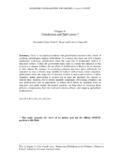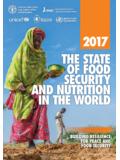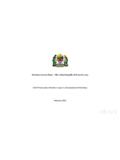Transcription of Conclusions of the Joint WHO/UNICEF/IAEA/IZiNCG ...
1 S480 Food and Nutrition Bulletin, vol. 28, no. 3 (supplement) 2007, The United Nations of the Joint WHO/UNICEF/IAEA/IZiNCG Interagency Meeting on Zinc Status IndicatorsSecretariat on behalf of the participants: Bruno de Benoist, Ian Darnton-Hill, Lena Davidsson, Olivier Fontaine, and Christine HotzAbstractZinc deficiency is an important cause of morbidity in developing countries, particularly among young children, yet little information is available on the global prevalence of zinc deficiency. A working group meeting was convened by the World Health Organization (WHO), the United Nations Children s Fund ( unicef ), the International Atomic Energy Agency (IAEA), and the International Zinc Nutrition Consultative Group (IZiNCG) to review methods of assessing population zinc status and provide standard recommendations for the use of specific bio-chemical, dietary, and functional indicators of zinc status in populations.
2 The recommended biochemical indica-tor is the prevalence of serum zinc concentration less than the age/sex/time of day-specific cutoffs; when the prevalence is greater than 20%, intervention to improve zinc status is recommended. For dietary indicators, the prevalence (or probability) of zinc intakes below the appropriate estimated average requirement (EAR) should be used, as determined from quantitative dietary intake assessments. Where the prevalence of inadequate intakes of zinc is greater than 25%, the risk of zinc deficiency is considered to be elevated.
3 Previous studies indicate that stunted children respond to zinc supplementation with increased growth. When the prevalence of low height-for-age is 20% or more, the prevalence of zinc deficiency may also be elevated. Ideally, all three types of indicators would be used together to obtain the best estimate of the risk of zinc deficiency in a population and to identify specific subgroups with elevated risk. These recommended indicators should be applied for national assessment of zinc status and to indicate the need for zinc interventions.
4 The prevalence of low serum zinc and inadequate zinc intakes may be used to evaluate their impact on the target population s zinc words: Diet, indicators, population, serum zinc, stunting, zincIntroductionZinc deficiency is among the most important causes of morbidity in developing-country settings. There is an urgent need to begin to identify countries and regions that are at increased risk for zinc deficiency and to quantify the number of individuals at risk on a global scale. To date, there are very limited data available at the country level on the risk of zinc deficiency.
5 In part, the assessment of zinc status may be hindered by the lack of standard, accepted guidelines on which indica-tors to use, how to carry out the assessment, and how to interpret the consultation workshop was convened by the World Health Organization (WHO), the International Atomic Energy Association (IAEA), and the United Nations Children s Fund ( unicef ) to review available indicators of population zinc status assessment and to present a set of recommendations to be adopted for international use. The three categories for population indicators considered were biochemical, dietary, and functional.
6 Potential indicators for each category were reviewed and are presented in detail in the accompany-ing articles of this supplement. Recommendations were derived for the specific indicators to use and for appro-priate cutoffs to interpret the level of risk of population zinc deficiency. The appropriateness of these indicators for monitoring the impact of zinc interventions was also considered. The recommendations from these papers and the consultation are summarized de Benoist is affiliated with the Department of Nutrition for Health and Development, World Health Organization, Geneva; Ian Darnton-Hill is affiliated with the Nutrition Section, unicef , New York; Lena Davidsson is affiliated with the Division of Human Health, International Atomic Energy Agency, Vienna; Olivier Fontaine is affiliated with the Department of Child and Adolescent Health and Development, World Health Organization, Geneva.
7 Christine Hotz is affiliated with HarvestPlus, Washington, direct queries to the corresponding author: O. Fontaine, WHO/CAH, 20 Via Appia 1211 Geneva - 27, Swit-zerland; e-mail: indicators of zinc statusBiochemical indicators may be used as an objective and quantitative means of assessing the zinc status of a population. Such indicators can be useful for iden-tifying populations and specific subgroups that are at elevated risk for zinc deficiency and may thus be used to identify groups to whom interventions should be targeted. Biochemical indicators may indicate the severity and extensiveness of zinc deficiency, although additional information will be needed as to the specific cause of the for the selection of biomarkers of zinc statusSerum or plasma zinc is the best available biomarker of the risk of zinc deficiency in populations.
8 The rationale for this selection is that serum or plasma zinc reflects dietary zinc intake; it responds consistently to zinc supplementation; and reference data are available for most age and sex groups. To date, serum zinc is the only biochemical indicator of zinc status known to meet these is recognized that serum zinc does not necessar-ily reflect individual zinc status or predict individual functional responses to supplementation; therefore, the use of this indicator for diagnosis and treatment of individuals is not recommended at this time.
9 However, information on the distribution of serum zinc concen-trations in a population will inform as to the magnitude of the risk of zinc deficiency at the population considerationsSerum zinc concentration is affected by recent meals, time of day, age, sex, and systemic infections or inflam-mation. Therefore, these factors should be taken into account in the survey design and be adequately controlled for in analysis to correctly interpret results. Because samples are easily contaminated by ambient sources of zinc, appropriate care must be taken during collection, processing, and analysis of samples to avoid contamination.
10 The sample included in the survey should be adequately representative of the population of for estimating the risk of zinc deficiency in a populationFor population assessment, the recommended indi-cator to use is the percentage of the population with serum zinc concentrations below the age/sex/time of day-specific lower cutoff [1 3].The recommended cutoffs are specific for age and sex groups as well as for the time of day of sampling and represent the percentile of the serum zinc distribution from a healthy reference population [1].
















